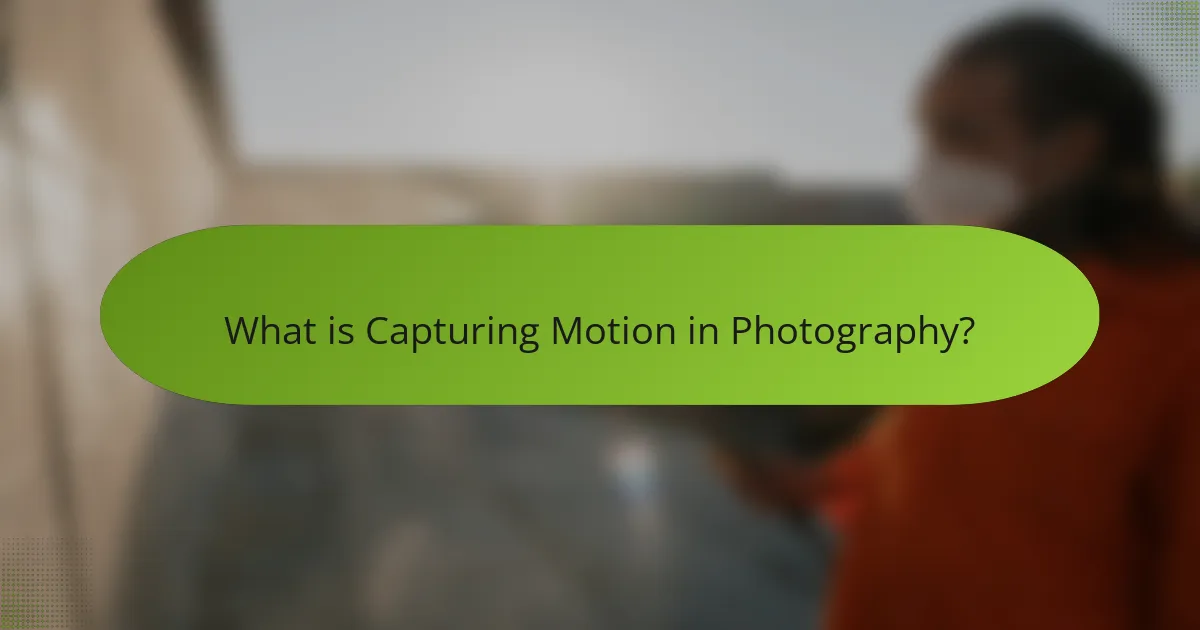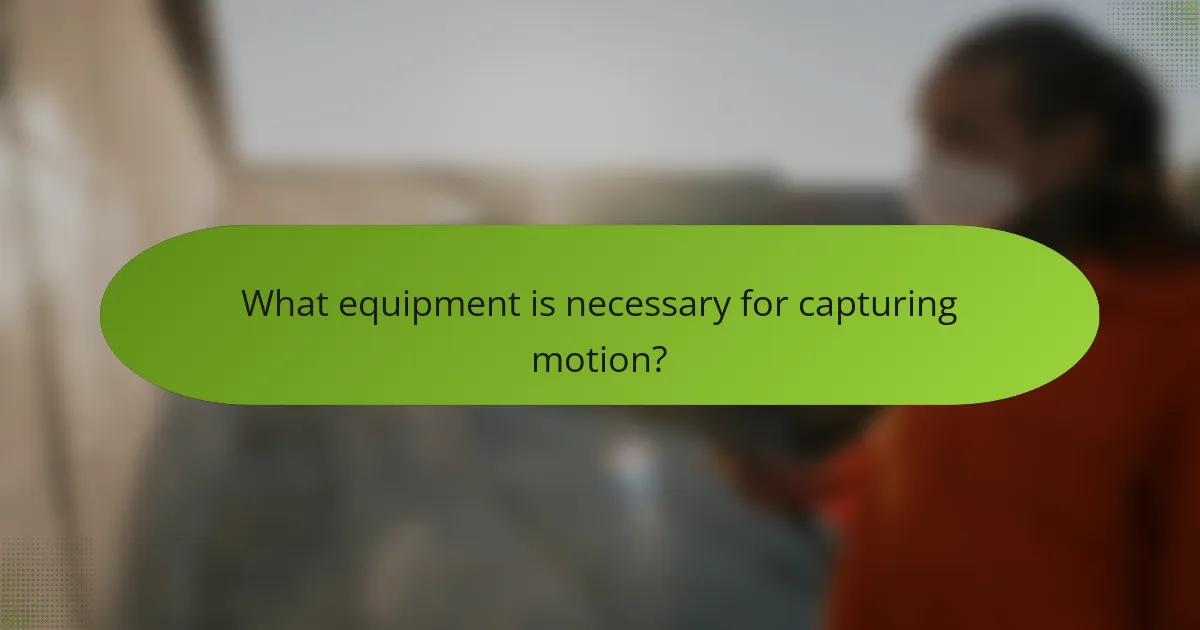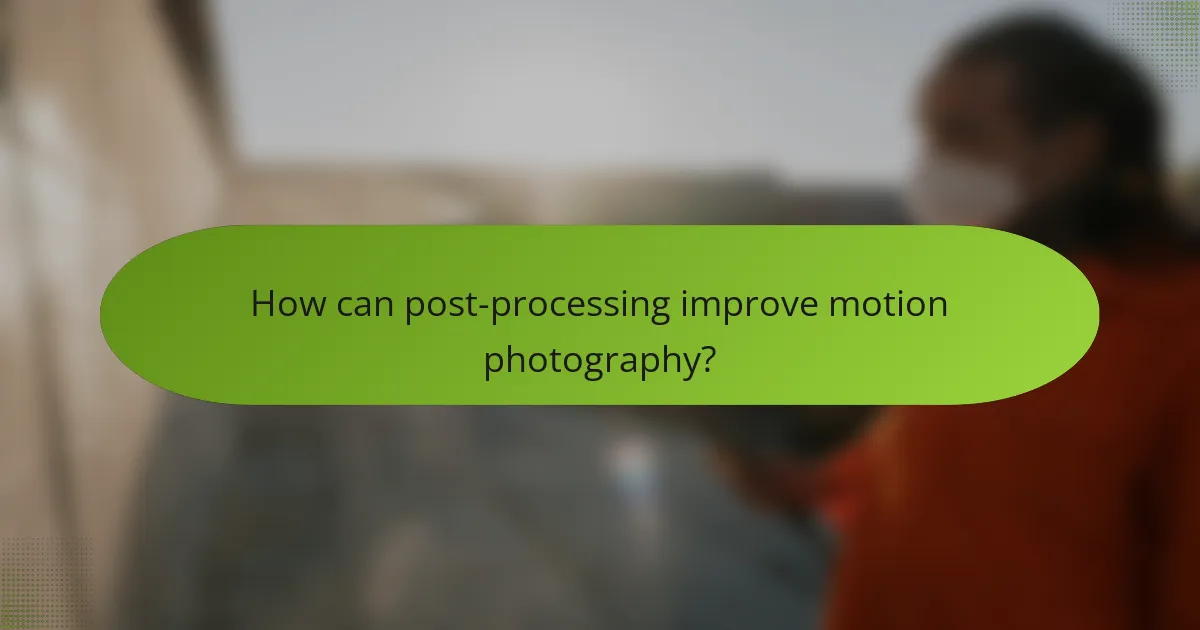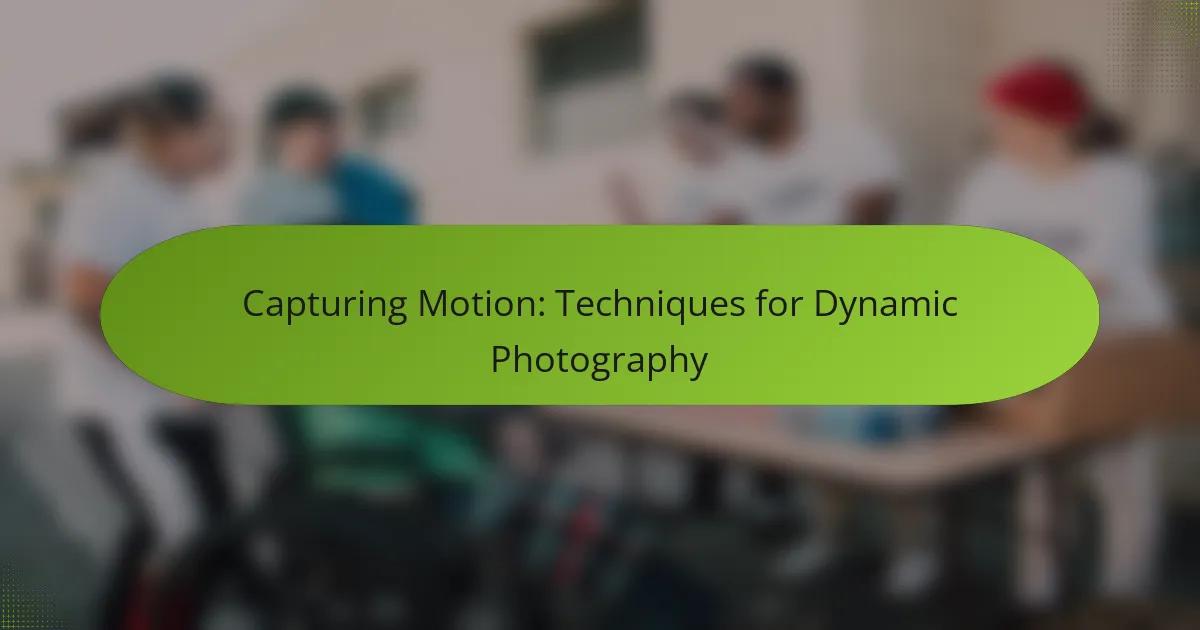
What is Capturing Motion in Photography?
Capturing motion in photography refers to the technique of depicting movement within a still image. This involves using various camera settings and techniques to convey the sense of action. Photographers often adjust shutter speed to either freeze motion or create a blur effect. A fast shutter speed can capture quick movements sharply, while a slow shutter speed can show the path of motion. Techniques such as panning can also enhance the depiction of motion by moving the camera in sync with a moving subject. The effectiveness of capturing motion is evident in sports photography, where dynamic scenes are common.
How does motion impact photographic composition?
Motion significantly impacts photographic composition by influencing the viewer’s perception and emotional response. It can create a sense of dynamism and energy in an image. Photographers often use techniques like motion blur to convey movement, which adds depth and context. The direction of motion can guide the viewer’s eye through the composition. Additionally, frozen motion can highlight action and detail, capturing moments that tell a story. The balance between static and dynamic elements can enhance visual interest. For example, a moving subject against a still background can create contrast and focus. Ultimately, how motion is represented shapes the overall narrative of the photograph.
What are the different types of motion in photography?
There are several types of motion in photography. The primary types include freezing motion, panning, and long exposure. Freezing motion captures a subject in sharp detail, often using a fast shutter speed. Panning involves moving the camera along with a moving subject, resulting in a sharp subject against a blurred background. Long exposure captures motion over time, creating a smooth blur effect that conveys movement. Each type serves different artistic purposes and techniques.
How can understanding motion enhance storytelling in images?
Understanding motion can significantly enhance storytelling in images by adding depth and context. Motion conveys action and emotion, making a scene more engaging. For instance, a photograph capturing a runner mid-stride can evoke feelings of determination and speed. This creates a narrative that static images may lack. Techniques such as motion blur can emphasize movement, drawing attention to the subject’s dynamics. Additionally, the timing of capturing a moment can illustrate a story’s progression. According to a study by the University of California, images that depict motion are often perceived as more compelling and memorable. This reinforces the idea that understanding motion is crucial for effective visual storytelling.
What techniques are essential for capturing motion effectively?
To capture motion effectively, use techniques such as panning, fast shutter speeds, and continuous shooting mode. Panning involves following a moving subject with the camera while taking a shot. This technique blurs the background and keeps the subject in focus, creating a sense of speed. Fast shutter speeds freeze motion, allowing for sharp images of fast-moving subjects. A shutter speed of 1/500th of a second or faster is often ideal for sports or wildlife photography. Continuous shooting mode enables multiple frames per second, increasing the chances of capturing the perfect moment. These techniques are widely used by photographers to enhance dynamic imagery.
How does shutter speed influence motion capture?
Shutter speed significantly influences motion capture by determining how long the camera sensor is exposed to light. A fast shutter speed freezes motion, capturing sharp images of moving subjects. For example, a shutter speed of 1/1000 second can freeze a basketball player in mid-jump. Conversely, a slow shutter speed allows for motion blur, conveying a sense of movement. A shutter speed of 1/30 second can create a blurred effect of a running athlete. This control over motion is crucial in dynamic photography. Photographers often adjust shutter speed based on the subject’s speed and desired effect. The choice impacts the visual storytelling in images.
What role does aperture play in dynamic photography?
Aperture plays a crucial role in dynamic photography by controlling the amount of light entering the camera. A wider aperture (lower f-stop number) allows more light, which is beneficial in low-light conditions. This enables faster shutter speeds, essential for freezing motion. Conversely, a narrower aperture (higher f-stop number) reduces light, leading to slower shutter speeds. This can create motion blur, which may be desirable for artistic effects. Additionally, aperture affects depth of field. A shallow depth of field isolates subjects, while a deeper depth of field includes more background detail. Therefore, adjusting aperture settings directly influences exposure, motion capture, and overall composition in dynamic photography.
Why is lighting important in capturing motion?
Lighting is crucial in capturing motion because it enhances visibility and highlights movement. Proper lighting can define the subject’s contours and create depth. It also affects shutter speed and exposure, which are vital for freezing or blurring motion. For instance, fast shutter speeds require adequate light to avoid underexposure. Conversely, low light conditions necessitate slower shutter speeds, which can introduce motion blur. Studies show that well-lit scenes produce clearer images with defined motion trails. Thus, effective lighting is essential for achieving dynamic and impactful photography.
How can natural light be utilized for dynamic shots?
Natural light can be utilized for dynamic shots by strategically positioning the subject and the camera to capture movement effectively. Using natural light enhances the texture and depth of the scene. Early morning or late afternoon light provides a soft, golden quality that adds warmth. This lighting can create dramatic shadows that emphasize motion.
Adjusting the angle of the light can change how the subject is perceived in motion. Backlighting can create silhouettes that highlight movement effectively. Utilizing reflectors can bounce light onto the subject, enhancing visibility while maintaining a natural look.
The direction of natural light influences the mood of the shot. Side lighting can accentuate details and create a three-dimensional effect. Experimenting with different times of day allows photographers to discover unique lighting conditions that enhance dynamic captures.
Incorporating these techniques can result in visually striking photographs that convey motion and energy.
What are the best artificial lighting techniques for motion photography?
The best artificial lighting techniques for motion photography include strobe lighting, continuous LED lights, and ring lights. Strobe lighting provides brief, intense bursts of light that freeze motion effectively. This technique is commonly used in studio settings for dynamic subjects. Continuous LED lights offer consistent illumination, allowing photographers to see the effects of lighting in real-time. This helps in adjusting settings for optimal exposure. Ring lights create soft, even lighting around the subject, reducing shadows and enhancing detail. Each technique can be adjusted in intensity and angle to suit the specific motion being captured, ensuring clarity and impact in the final images.

What equipment is necessary for capturing motion?
To capture motion effectively, a camera with high shutter speed capabilities is essential. A DSLR or mirrorless camera is ideal for this purpose. These cameras allow for quick adjustments to settings. A sturdy tripod stabilizes the camera during long exposure shots. A fast lens, such as a prime lens with a wide aperture, enhances light intake. Additionally, using external flashes can freeze motion in low light conditions. Filters, like ND filters, help manage light exposure during bright conditions. Lastly, a remote shutter release minimizes camera shake during capture. Each piece of equipment plays a crucial role in achieving sharp and dynamic motion photography.
What camera settings are crucial for dynamic photography?
The crucial camera settings for dynamic photography include shutter speed, aperture, and ISO. Shutter speed should be fast enough to freeze motion, typically 1/500 seconds or faster for moving subjects. Aperture affects depth of field; a wider aperture (lower f-stop number) allows more light and can blur backgrounds. ISO should be adjusted to maintain proper exposure without introducing noise; higher ISO settings are useful in low light but can reduce image quality. These settings work together to capture sharp, dynamic images effectively.
How do different camera modes affect motion capture?
Different camera modes significantly impact motion capture by altering exposure settings and frame rates. For instance, using a sports mode prioritizes fast shutter speeds. This reduces motion blur, capturing quick movements clearly. Conversely, portrait mode may introduce slower shutter speeds, which can result in blurred motion.
In low-light situations, night mode increases exposure time. This can lead to more motion blur if subjects are moving. High frame rate modes allow for smoother slow-motion playback. This captures more frames per second, providing detailed motion analysis.
Each mode is designed for specific scenarios, optimizing performance based on the environment and subject movement. Understanding these differences enables photographers to choose the appropriate settings for their dynamic photography needs.
What accessories enhance motion photography performance?
Tripods enhance motion photography performance by providing stability. They reduce camera shake during long exposures. Gimbals also improve stability, allowing smooth panning and tilting. These devices help capture fluid motion in dynamic scenes. A remote shutter release prevents camera movement when taking photos. ND filters control light intake, enabling longer exposures without overexposing. Fast lenses with wide apertures capture more light, essential for freezing motion in low light. Lastly, external flashes can freeze action with quick bursts of light. Each accessory plays a vital role in achieving high-quality motion photography.
What types of lenses are best for capturing motion?
Fast prime lenses and telephoto lenses are best for capturing motion. Fast prime lenses have wide apertures, allowing for quick shutter speeds. This reduces motion blur and captures sharp images. Telephoto lenses enable photographers to zoom in on distant subjects. They compress the scene and can isolate moving subjects effectively. Both lens types are favored in sports and wildlife photography. They enhance the ability to freeze action in dynamic environments.
How does focal length impact motion photography?
Focal length significantly impacts motion photography by influencing the perspective and framing of moving subjects. A shorter focal length, such as 18mm, captures a wider field of view. This allows for more of the scene to be included, making it easier to depict motion in context. Conversely, a longer focal length, like 200mm, compresses the scene and isolates the subject. This can create dramatic effects but may lose some environmental context.
Additionally, focal length affects depth of field. Shorter focal lengths provide a greater depth of field, keeping more elements in focus. This is beneficial for capturing fast-moving subjects in a broader context. Longer focal lengths result in a shallower depth of field, which can emphasize the subject but may blur the background.
The choice of focal length also influences the motion blur effect. A shorter focal length can maintain clarity in fast-moving scenes, while longer focal lengths may require faster shutter speeds to avoid motion blur. Understanding these effects is crucial for effectively capturing motion in photography.
What are the advantages of using prime versus zoom lenses for motion?
Prime lenses offer advantages for motion photography due to their wider apertures and superior image quality. Wider apertures, such as f/1.8 or f/1.4, allow more light to enter, enabling faster shutter speeds. This is crucial for freezing motion and avoiding blur.
In contrast, zoom lenses typically have smaller maximum apertures, which can limit performance in low-light conditions. Prime lenses also tend to have better optical quality, with fewer glass elements leading to sharper images and reduced distortion.
Additionally, using a prime lens encourages photographers to be more intentional with composition and framing. This can lead to more creative and dynamic shots. In practice, many professionals prefer primes for their clarity and ability to perform well in challenging lighting.
Overall, the advantages of prime lenses for motion include faster apertures, superior image quality, and enhanced creative control.

How can post-processing improve motion photography?
Post-processing can significantly enhance motion photography by refining images and emphasizing movement. It allows photographers to adjust exposure, contrast, and color balance, which can highlight dynamic elements. Techniques like motion blur can be applied to create a sense of speed and fluidity. Additionally, cropping can focus on the subject, eliminating distractions. Noise reduction enhances image clarity, especially in low-light conditions. Sharpening tools can define edges, making fast-moving subjects stand out. Overall, post-processing transforms raw images into visually compelling representations of motion.
What editing techniques can enhance motion blur effects?
Editing techniques that can enhance motion blur effects include the use of Gaussian blur, direction blur, and layer masking. Gaussian blur can create a smooth motion effect by blurring the entire image or specific areas. Direction blur simulates movement in a specific direction, enhancing the sense of speed. Layer masking allows for selective application of blur, maintaining sharpness in key areas while blurring others. These techniques can be applied in software like Adobe Photoshop or After Effects. Studies show that these methods effectively convey motion, making images more dynamic and engaging.
How can contrast and color grading affect dynamic images?
Contrast and color grading significantly enhance the visual impact of dynamic images. Increased contrast can emphasize movement by making subjects stand out against their backgrounds. This technique helps to draw the viewer’s eye to the action occurring in the image. Color grading alters the mood and tone of dynamic images, influencing the emotional response of the audience. For instance, warmer tones can evoke excitement, while cooler tones may convey calmness. Studies show that effective color grading can improve viewer engagement by up to 30%. In dynamic photography, these adjustments can transform a simple moment into a compelling visual narrative.
What are common challenges in capturing motion?
Common challenges in capturing motion include motion blur, low light conditions, and focus issues. Motion blur occurs when the subject moves faster than the camera’s shutter speed. This can result in unclear images. Low light conditions make it difficult to use fast shutter speeds. As a result, images may turn out dark or grainy. Focus issues arise when tracking a moving subject, leading to missed shots or out-of-focus images. Additionally, camera shake can affect sharpness. These challenges require specific techniques to overcome, such as using faster shutter speeds and stabilizing equipment.
How can photographers overcome issues with focus during motion capture?
Photographers can overcome focus issues during motion capture by using continuous autofocus modes. These modes track moving subjects, adjusting focus in real-time. Additionally, employing faster shutter speeds can help freeze motion, making focus easier. Utilizing a wider aperture increases the depth of field, allowing for more forgiving focus. Photographers should also practice panning techniques to maintain focus on moving subjects. Lastly, pre-focusing on a specific area where the action will occur can improve accuracy. These methods are widely recognized in photography circles for enhancing focus during dynamic scenes.
What strategies can help in low-light motion photography?
Use a wide aperture to allow more light into the camera. A wide aperture, like f/2.8 or lower, improves exposure in low light. Increase the ISO setting to make the camera sensor more sensitive to light. Higher ISO values, such as 1600 or 3200, can help capture motion without blur. Employ image stabilization techniques to reduce camera shake. Image stabilization can be crucial for handheld shots in low-light conditions. Utilize a slower shutter speed to capture motion blur artistically. Shutter speeds around 1/30 to 1/60 seconds can effectively convey movement. Consider using a tripod for stability during longer exposures. A tripod can help maintain sharpness in low-light situations. Finally, experiment with ambient light sources to enhance your composition. Using available light creatively can lead to unique and dynamic images.
What are some practical tips for capturing motion in photography?
To capture motion in photography effectively, use a fast shutter speed. A shutter speed of 1/500 seconds or faster can freeze fast-moving subjects. Alternatively, use a slower shutter speed for motion blur effects. This creates a sense of movement. Panning with the subject while shooting can also yield dynamic results. Use continuous shooting mode to increase your chances of capturing the perfect moment. Adjust your aperture and ISO settings to maintain proper exposure. Lastly, practice timing and anticipation to predict movement patterns, enhancing your ability to capture action shots.
How can photographers practice and refine their motion capture skills?
Photographers can practice and refine their motion capture skills by engaging in specific exercises and techniques. They can start by experimenting with different shutter speeds to see how they affect motion blur. Practicing panning techniques while following moving subjects enhances the ability to capture sharp images. Additionally, using continuous shooting modes allows photographers to take multiple shots in quick succession, increasing the chances of capturing the perfect moment.
Setting up controlled environments, such as using a model or a moving object, helps in understanding motion dynamics. Photographers can also analyze their work by reviewing images to identify areas for improvement. Participating in workshops or online courses focused on motion photography provides valuable insights and feedback.
Lastly, studying the work of renowned motion photographers can inspire new approaches and techniques. These methods collectively enhance a photographer’s ability to capture motion effectively.
What are the best scenarios for experimenting with motion photography?
The best scenarios for experimenting with motion photography include sports events, bustling city streets, and nature scenes. Sports events provide fast-paced action, allowing for dramatic captures of athletes in motion. Bustling city streets offer dynamic subjects, such as pedestrians and vehicles, creating a lively atmosphere. Nature scenes, like waterfalls or windy fields, showcase the beauty of movement in natural elements. Additionally, capturing moving animals can highlight the grace and speed of wildlife. Each scenario allows photographers to explore different techniques, such as panning and long exposure, to enhance the sense of motion.
Capturing motion in photography is the primary focus of this article, detailing techniques and settings that effectively depict movement in still images. Key topics include the impact of shutter speed, aperture, and lighting on motion capture, as well as essential techniques such as panning and long exposure. The article also explores various types of motion, the role of equipment, and post-processing methods to enhance dynamic imagery. Additionally, it addresses challenges photographers may face in capturing motion and offers practical tips for refining their skills.
